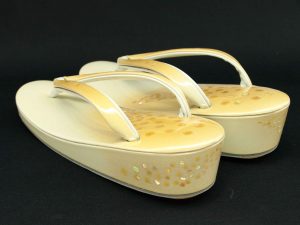Footwear items from Tsujiya Honten are all one-of-a-kind, semi-made-to-order products. With such a variety of designs from a simple shape, they are truly a work of Japanese traditional art and just looking at them brings joy.
Geta -下駄-

Wooden base footwear fit with a thong. Originally crafted in ancient Japan as a tool for work, they later became fashionable footwear. A wide variety of platforms exist depending on the shape of the “teeth.” They are more suited towards everyday wear than zouri. Materials used include pine and cedar, but Tsujiya Honten mainly sells those made with the light, highly absorbent paulownia wood, as it is the highest quality material for geta. Paulownia geta vary in price based on the width of the straight grain (tree rings), number of trees used, and how the pieces are arranged.
Zouri -草履-

Different varieties of zouri can be worn depending on the time, place, and occasion, from casual to formal. zouri for both men and women are made from either cork board or urethane bases with actual or synthetic leather covering, and are fitted with thongs. Besides leather, the base tops can also be covered with bamboo, canvas, rattan and the like, or synthetic materials.
Setta -雪駄-
 A type of zouri worn mainly by men, the leather bottom is directly attached to the top in a construction called jikazuge. The top is woven with bamboo, leather, or synthetics, and leather is sewn onto the bottom. Steel nails are then pounded into the sole to hold everything together. Sekida, as setta were once called, are thought to have been conceived for tea master Sen no Rikyu to wear on walks in his teahouse garden on snowy days. The name was corrupted to setta as they migrated to Eastern Japan.
A type of zouri worn mainly by men, the leather bottom is directly attached to the top in a construction called jikazuge. The top is woven with bamboo, leather, or synthetics, and leather is sewn onto the bottom. Steel nails are then pounded into the sole to hold everything together. Sekida, as setta were once called, are thought to have been conceived for tea master Sen no Rikyu to wear on walks in his teahouse garden on snowy days. The name was corrupted to setta as they migrated to Eastern Japan.


